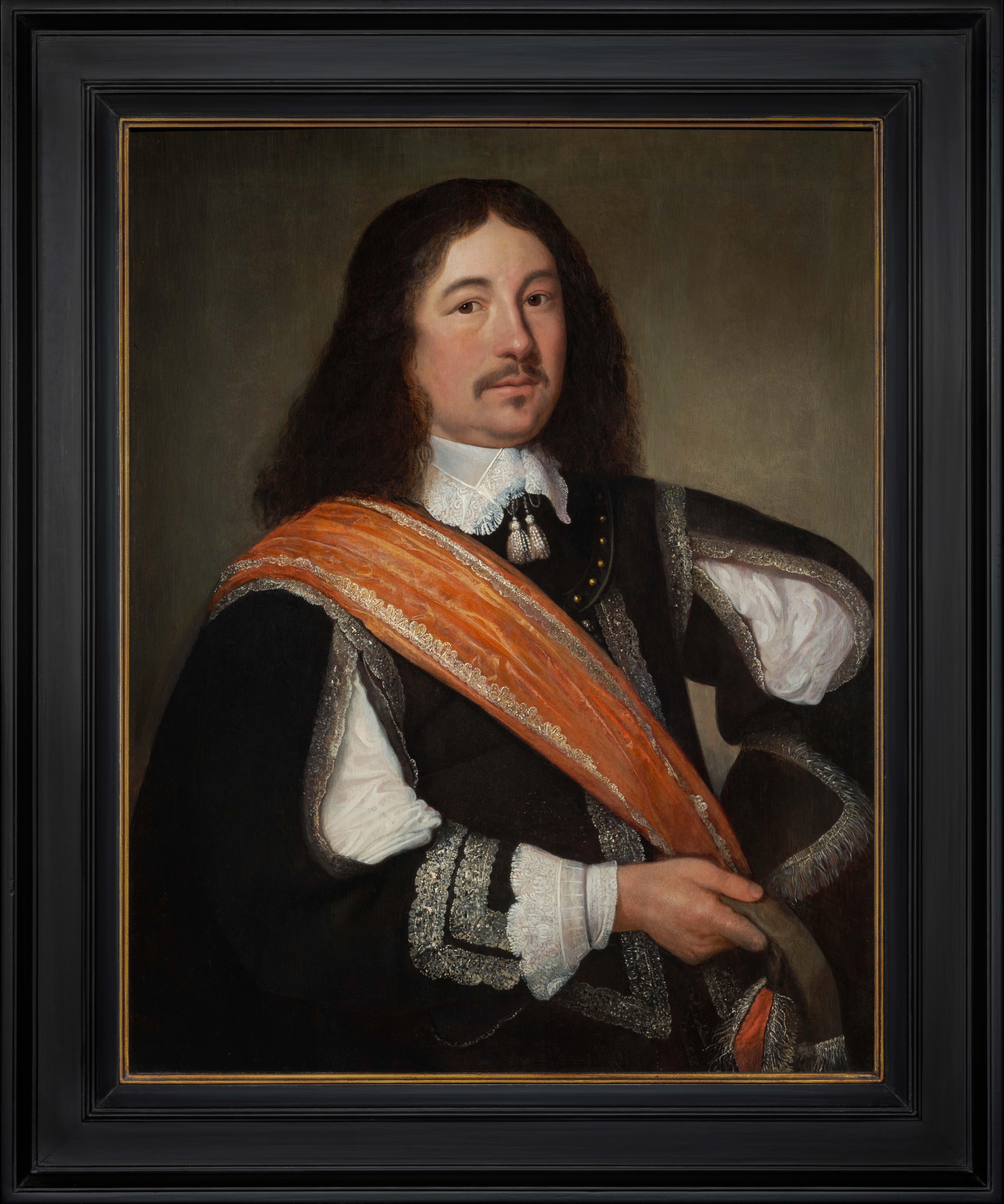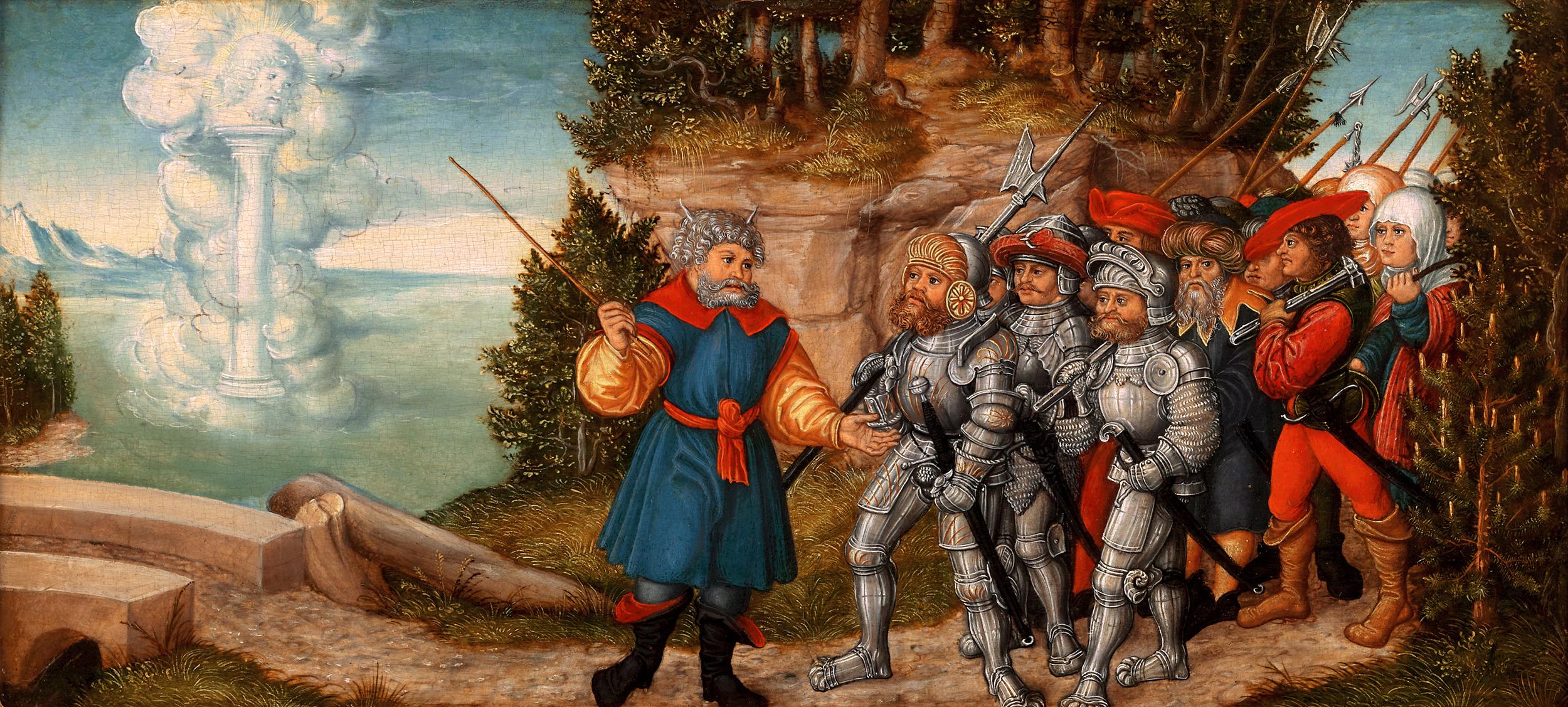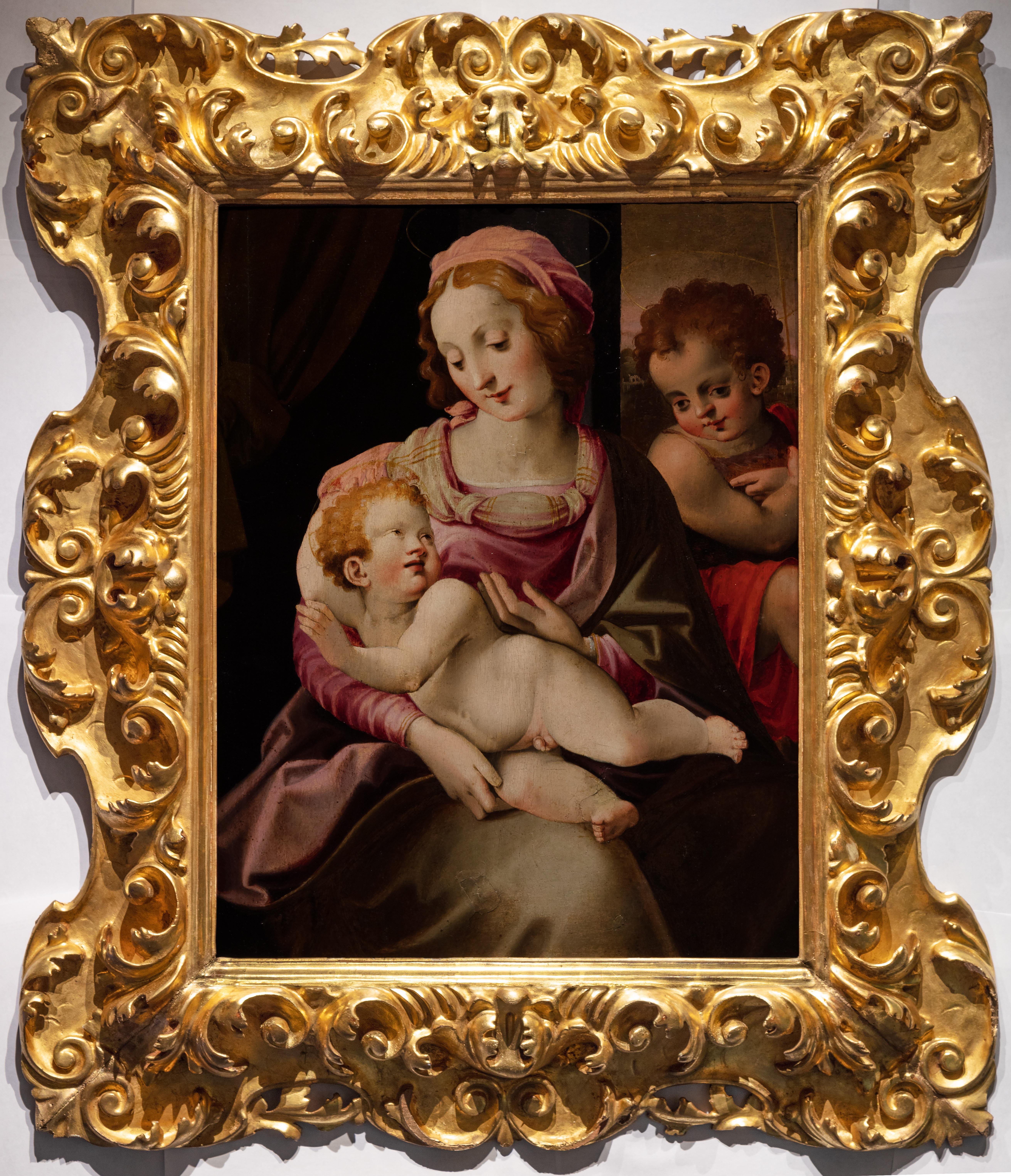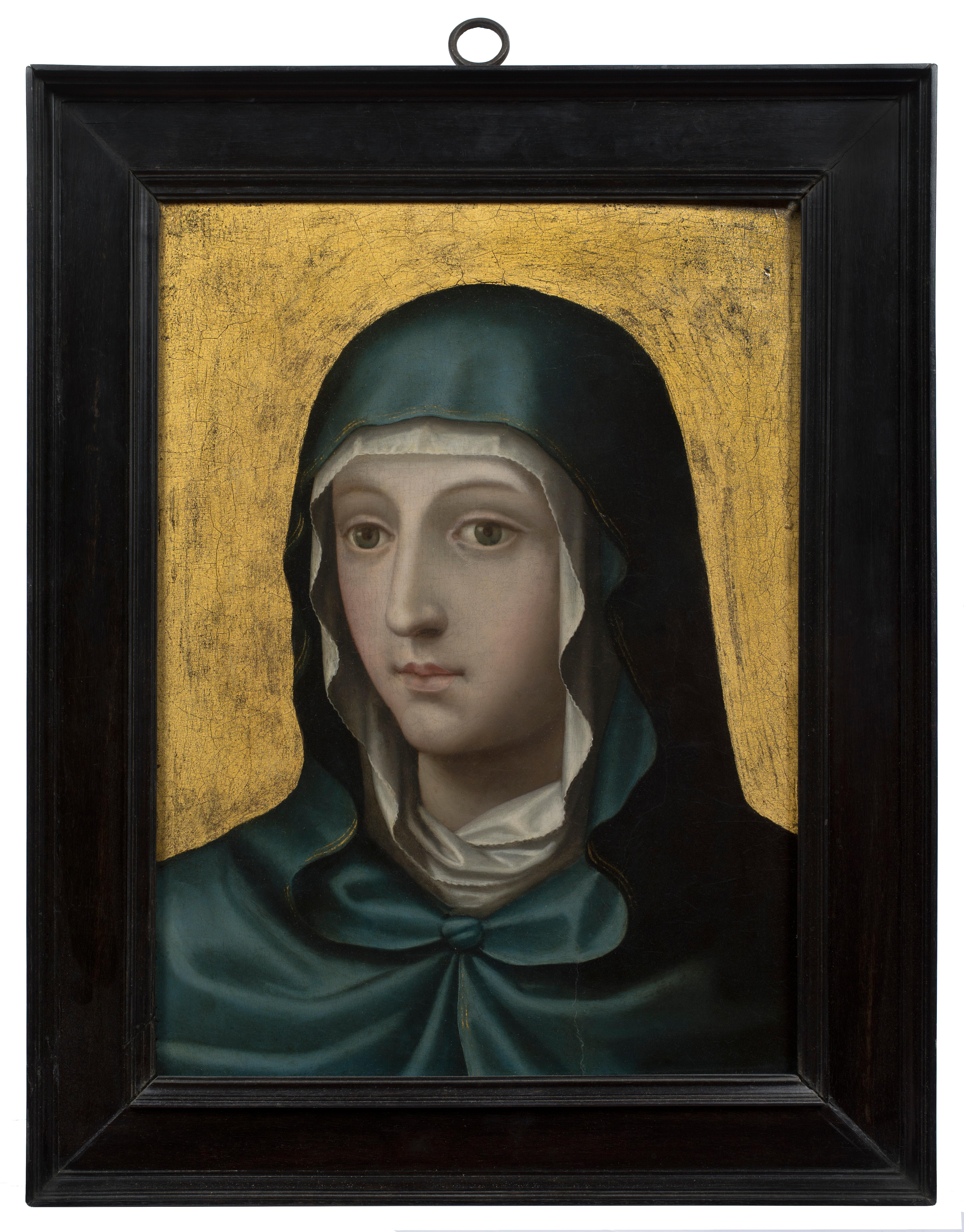Items Similar to The Temptation of Saint Anthony
Want more images or videos?
Request additional images or videos from the seller
1 of 3
Cornelis SaftlevenThe Temptation of Saint Anthony
About the Item
Oil on panel
We'd like to thank dr. Jan De Maere for his advice.
In Cornelis Saftleven's arresting depiction of the temptation of Saint Anthony, the viewer is drawn into a surreal realm where the boundary between reality and nightmare blurs. At the heart of the composition, Saint Anthony, perhaps represented by the humble peasant-like figure in the background, stands as a beacon of virtue amidst a phantasmagoria of malevolent creatures.
Saftleven's canvas pulses with an otherworldly energy, as grotesque amalgamations of animals and skulls loom menacingly, their forms twisting and contorting in eerie dance. Each creature, rendered with a masterful blend of browns and golden hues, exudes a sinister allure, their eyes pools of darkness punctuated by glistening white specks that seem to fixate on the viewer with unsettling intensity.
Born into a family steeped in artistic tradition, Saftleven honed his craft alongside his father Herman and brothers Abraham and Herman the Younger, their collective legacy resonating in the breadth of his oeuvre. While Saftleven's subjects spanned a wide array of themes, from biblical narratives to scenes of everyday life, it was his uncanny ability to conjure visions of hell and allegorical motifs that garnered particular acclaim.
Central to Saftleven's artistic prowess was his virtuosity in capturing the essence of animals, endowing them with a vitality and agency that transcended mere representation. Indeed, in the temptation of Saint Anthony, these creatures emerge as active participants, their presence laden with symbolic significance, hinting at deeper layers of meaning concealed within the enigmatic narrative.
As a draftsman, Saftleven's skill was equally renowned, his black chalk drawings revealing an affinity for single figures and intricate studies of animals, echoing the influence of Roelandt Savery. Yet it is perhaps in works like this haunting portrayal of Saint Anthony's struggle against temptation that Saftleven's singular vision truly shines, beckoning the viewer into a realm where the boundaries between light and shadow, reality and illusion, blur into tantalizing ambiguity.
- Creator:Cornelis Saftleven (1607 - 1681, Dutch)
- Dimensions:Height: 9.85 in (25 cm)Width: 10.24 in (26 cm)
- Medium:
- Movement & Style:
- Period:
- Condition:
- Gallery Location:Gent, BE
- Reference Number:1stDibs: LU2239214415192
About the Seller
No Reviews Yet
Vetted Seller
These experienced sellers undergo a comprehensive evaluation by our team of in-house experts.
Established in 1999
1stDibs seller since 2022
- ShippingRetrieving quote...Ships From: Gent, Belgium
- Return PolicyThis item cannot be returned.
More From This SellerView All
- Mary Magdalene praying in her caveLocated in Gent, BEImmerse yourself in the serene spirituality and masterful technique of David Teniers the Elder with this evocative depiction of Mary Magdalene in her cave. Trained under the tutelage...Category
17th Century Old Masters Figurative Paintings
MaterialsOil, Panel
- A bird concertLocated in Gent, BEOil on panel We'd like to thank dr. Jan De Maere for his advice. The exquisite detail and vibrant composition of this painting attributed to Jan Baptist Bouttats, show a versatile ...Category
17th Century Old Masters Animal Paintings
MaterialsOil, Panel
- Two Sunny animated landscapes with travellers with a river view, a town beyondLocated in Gent, BEOil on panel Comes with a certificate by dr. Jan De Maere "In my opinion they are early works, inspired by the river views of Jan Griffier the Elder, the italianate coulisses by Dir...Category
Early 18th Century Old Masters Landscape Paintings
MaterialsOil, Panel
- The PipesmokerLocated in Gent, BEImmerse yourself in the charm of Dutch Golden Age artistry with this captivating piece by Edward Collier, an acclaimed still-life painter renowned for his vanitas and trompe-l'œil wo...Category
17th Century Old Masters Figurative Paintings
MaterialsWood Panel, Oil
- Landscape with travellers near a bridge - Attributed to Goffredo WalsLocated in Gent, BEOil on oval lime wood panel Collection number on the back: 272 We see a herd of goats and their shepherds on the bridge, one of the shepherds is on a horse, the others look at the men near the riverbank. Two standing figures are pointing and discussing with one another, while the other one is sitting and relaxing after a long trip. We'd like to thank dr. Guido Jansen for his attribution. Goffredo Wals was a German painter, who spent most of his career in Italy. Most of his works were in small format, often circular and painted on copper...Category
17th Century Old Masters Landscape Paintings
MaterialsOil, Wood Panel
- Portrait of three children - Bernhard Keil (1624-1687)Located in Gent, BE“A portrait of three children, one of them holding a basket of grapes, while another plays the flute” Oil on canvas Housed in a blackened 17th-century frame. We'd like to thank dr...Category
17th Century Old Masters Portrait Paintings
MaterialsOil, Panel
You May Also Like
- Portrait of a ManLocated in New York, NYProvenance: with Leo Blumenreich and Julius Böhler, Munich, 1924 Dr. Frederic Goldstein Oppenheimer (1881-1963), San Antonio, Texas; by whom given to: Abraham M. Adler, New York, until 1985; thence by descent to the present owners While old inscriptions on the verso of this panel propose its author to be Hans Holbein and the sitter Sir John More—a lawyer, judge, and the father of Sir Thomas More—this fine portrait has long been recognized to be by a Flemish hand. Max Friedländer gave the painting to Bernard van Orley (1487/1491 – 1541) in 1924, but did not include it in the volume dedicated to the artist in his Early Netherlandish Paintings...Category
16th Century Old Masters Portrait Paintings
MaterialsOil, Panel
- Portrait Gentleman Black Coat Orange Sash, Dutch Old Master, Oil on Panel c.1650By Bartholomeus van der HelstLocated in London, GBThis exquisite portrait of a gentleman depicted in a sumptuous black coat edged with silver and slashed sleeves is an excellent example of the type of portrait fashionable in England and the Low Countries during the 17th century. The confident pose, striking orange sash - the colour of the house of Orange Nassau - and the leather gorget imbue the sitter with a sense of masculinity and power. The profusely decorated costume is of the highest quality and de rigueur of an elite class - the artist has carefully cultivated this portrait to emphasise the sitter’s wealth and standing in the society that he belonged to. The casual pose, with one arm resting on a hip, is much less formal than earlier decades, and it speaks of ‘sprezzatura’ – one’s appearance should not appear laborious, but instead, effortless. The oil on cradled panel portrait can be dated to circa 1650 based on the hairstyle and the attire - small falling collar, short doublet (doublets reduced in size to just below the ribcage in the late 1650’s), and the type of slashed sleeves with the sleeve seams left open to reveal the white fabric. The demand for portraits in the Netherlands was great in the 17th century. Bartholemeus van der Helst was considered to be one of the leading portrait painters of the Dutch Golden Age surpassing even Rembrandt as the most sought-after portraitist in Harlaam. The Dutch Golden Age, roughly spanning the 17th century, was a period when Dutch trade, science, military, and art were among the most acclaimed in the world. Dutch explorers charted new territory and settled abroad. Trade by the Dutch East-India Company thrived, and war heroes from the naval battles were decorated and became national heroes. During this time, The Dutch Old Masters began to prevail in the art world, creating a depth of realistic portraits of people and life in the area that has hardly been surpassed. The Golden Age painters depicted the scenes that their discerning new middle-class patrons wanted to see. This new wealth from merchant activities and exploration combined with a lack of church patronage, shifted art subjects away from biblical genres. Still life’s of items of everyday objects, landscapes, and seascapes reflecting the naval and trade power that the Republic enjoyed were popular. The new wealthy class were keen to have their portraits commissioned and many artists worked in this lucrative field. Such was the popularity of art that everyone had a painting, even the humble butcher, and hundreds of thousands of paintings were produced. By tradition the sitter is Maarten Tromp (1598-1653) who was an Admiral in the Dutch Navy (the reverse of the portrait contains an old handwritten inscription “van Tromp”). Certainly, the distinctive orange sash is similar to those worn by officers of the Dutch army in the Netherlands who served under the Princes of Orange and the House of Nassau. However, it should be noted that the physiognomy differs from other images of Tromp. Tromp was the oldest son of Harpert Maertensz, a naval officer and captain. He joined the Dutch navy as a lieutenant in July 1622 and was later promoted from captain to Lieutenant-Admiral of Holland and West Frisia in 1637. In 1639, during the Dutch struggle for independence from Spain, Tromp defeated a large Spanish fleet bound for Flanders at the Battle of the Downs, which marked an enormous change - the end of Spanish naval power. He was killed in action during the First Anglo-Dutch War in 1653 where he commanded the Dutch fleet in the battle of Scheveningen. Gloves were an absolutely vital accessory and the elaborate pair in this portrait are embellished with threads of silk and precious metals and salmon-coloured lining. He wears only one glove and holds the other, providing an opportunity to better display the cuffs and detail on his right wrist and forearm. The gloves are probably made from the most prized leather which came from Spain, in particular from Cordova. Cordovan leather was tanned with a special vegetal process that left it both highly impermeable and divinely soft. King Charles I, posed in a rather relaxed manner for Daniel Mytens’s portrait in 1631, is wearing gloves and boots in matching Cordovan leather. The hide is thick, but you can see just how supple it is from the way the gauntlet dimples and the long boot legs fold over themselves, rippling and wrinkling at the ankles. Apart from keeping hands warm the use of gloves during the 15th through the 19th centuries were full of symbolism and they were worn regardless of the season. They kept the skin unblemished - soft, smooth hands were considered highly attractive. This combination of necessity and proximity to bare skin made gloves a deeply personal gift and they took on a strong symbolic significance and were regarded as emblematic of fidelity and loyalty for hundreds of years. Such was the importance of their symbolism was that some gloves were never intended to be worn at all. Their luxury made them ideal gifts at court, and so in the 15th and 16th centuries, ambassadors often presented them as symbols of loyalty. Until the mid-19th century, it was customary to give gloves as tokens to guests at weddings and to mourners at funerals. Gentleman often gifted their bride-to-be with a pair of gloves (the obligatory gift) and were handed over at the betrothal and put on display before the wedding took place. It was probably their direct contact with the skin that led to the eroticism of gloves. Not only were pairs often exchanged between lovers, but from the 16th to the 18th centuries, it was common practice to remove one glove and give it as a gift to a favourite. The idea of the item being presented still warm from the wearer’s hand is certainly suggestive. Following the death of King George IV, his executors purportedly found over a thousand mismatched ladies’ gloves among his possessions. The sentiment of a 17th-century poem reveals the popularity of the practice: “Come to our wedding to requite your loves / Shew us your hands and we’ll fit you with gloves.” Such generosity might be pricey for the hosts, but gloves of varying quality could be offered depending on the status of the recipient. Pairs made with the finest Spanish leather might be reserved for immediate family, while coarse sheep’s leather could be distributed among the servants and tradesmen. The apportioning of quality according to class provided a very clear message of the gloves’ intended use. For refined guests, they were decoration; for the lower classes, they were functional. Bartholomeus van der Helst...Category
17th Century Old Masters Portrait Paintings
MaterialsOil, Wood Panel
- Moses and the Pillar of Cloud by Lucas Cranach the Elder and StudioBy Lucas Cranach the ElderLocated in New Orleans, LALucas Cranach the Elder and Studio 1472-1553 German Moses and the Pillar of Cloud Oil on panel Moses and the Pillar of Cloud is a bold and evocative composition that showcases the signature intense color and intricate detail of Lucas Cranach the Elder’s celebrated oeuvre. The remarkable 16th-century oil on panel by Lucas Cranach and his studio captures the narrative moment when Moses leads the Israelites out of Egypt and encounters God manifested through a large pillar of cloud. Moses stands at the precipice of a bridge and turns back to soldiers helping to lead the group of Israelites who huddle closely together. Cranach depicts Moses with his traditional iconography, rendering the rays of light on his head which came to be interpreted as "horns" in the translation of the Bible. Using his traditional walking staff, Moses gestures toward the pillar, seemingly acknowledging that God will protect the group as they cross the bridge to the other side, leaving exile and entering a promised land. In a nod to Cranach’s Germanic locale, he renders the figures and setting in a manner that feels decisively more akin to European aesthetics than those of the Red Sea. Soldiers wear elaborate, gothic suits of armor that recall the livery of Northern European guardsmen. The terrain appears more like a European forest giving way to a sweeping valley than the arid landscape the Israelites trekked through on their journey across the Red Sea. Though still clearly recounting a story from the Old Testament, Cranach renders the cast of characters and setting in an earthly, familiar manner. This aesthetic shift speaks to Cranach’s own changing beliefs as he found himself at the center of the Protestant Reformation. After first gaining recognition in 1505 as the official painter of Frederick the Wise, Cranach established a thriving painting and print studio in Wittenberg, Germany. Cranach was renowned for his court portraits and genre paintings and was also well known for his association with the famous protestant reformer Martin Luther, then under the protection of Frederick the Wise. As Wittenberg became a bastion of new religious thought, Cranach soon befriended Luther and played an active role in creating the printed materials that proliferated throughout the Reformation...Category
16th Century Old Masters Figurative Paintings
MaterialsOil, Panel
- Madonna and Child with the Infant Saint John the BaptistLocated in New York, NYInscribed, reverse: Fr Brina Provenance: Private Collection, New Jersey. Francesco Brina was one of the “Studiolo” painters, responsible for the panel of Neptune and Amphitrite in F...Category
16th Century Old Masters Paintings
MaterialsOil, Wood Panel
- The Veronica of the Virgin (Verónica de la Virgen)Located in New York, NYThe panel has been attributed both to Joan de Joanes and his son Vicente Macip Comes (Valencia, ca. 1555 – 1623). Provenance: Private Collection, England, by 1886 (according to stencils on the reverse) Private Collection, New Jersey, until 2010 The Veil of Veronica, often called the Sudarium, is one of the most important and well-known relics of Christ. According to legend, Veronica offered Christ her veil as he carried the cross to his crucifixion. He wiped his face with the veil, which left the cloth miraculously imprinted with his image. Depictions of Christ’s face on a veil, or simply images that focused in on Christ’s face, were treasured objects of religious devotion. The popularity of this format also inspired similar images of the face of the Virgin. The iconographic type of the present painting is known as the Veronica of the Virgin, which was especially favored in late medieval and early Renaissance Spain. Distinct from the images of the suffering Christ, the Veronica of the Virgin is based on the legend that Saint Luke painted a portrait of Mary from life. Although scholars have sometimes mistaken them for portraits of Queen Isabella I of Castile (known as Isabel la Católica) or as a depiction of Saint Maria Toribia (known as María de la Cabeza, or, Mary of the Head), paintings like this one were clearly intended as images of the Virgin in the style of Saint Luke’s lost portrait. The Veronica of the Virgin was especially popular in Valencia, and depictions of this subject produced there all stem back to one visual prototype: a Byzantine image in the city’s cathedral (Fig. 1). This early treatment of the Veronica was given to the cathedral in 1437 by Martin the Humane, King of Aragon and Valencia, who promoted religious veneration of the Veronica of the Virgin as part of the celebration of the Immaculate Conception of Mary. This devotion spread throughout Martin’s kingdom and particularly took hold in Valencia, where the Byzantine image resided. The image, which is displayed in a gold reliquary...Category
16th Century Old Masters Paintings
MaterialsOil, Wood Panel
- Portrait of a Man, 17th Century Dutch Oil on Panel PortraitBy Cornelis DusartLocated in London, GBCircle of Cornelis Dusart Dutch 1660 - 1704 Portrait of a Man Oil on panel Image size: 7¾ x 5¼ inches Giltwood frame Cornelis Dusart Cornelis ...Category
17th Century Old Masters Portrait Paintings
MaterialsOil, Panel





